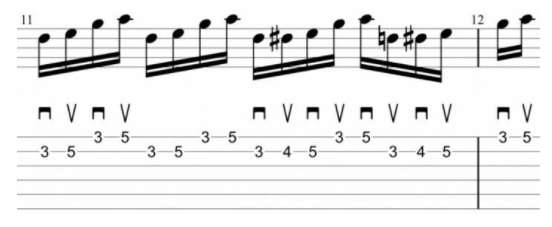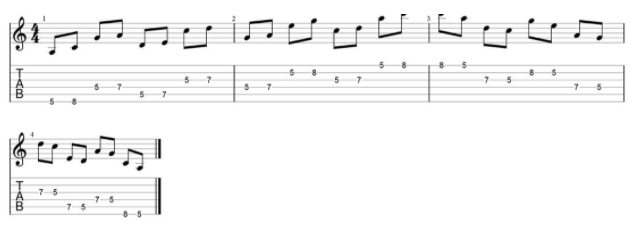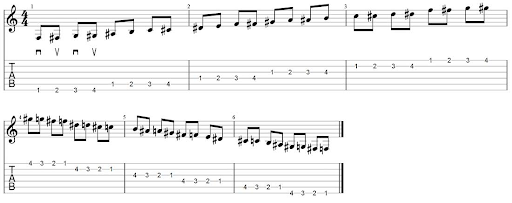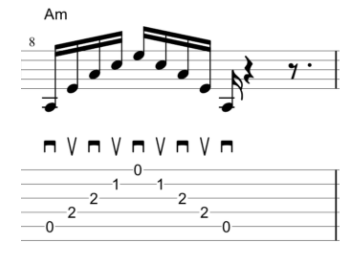Guitar players, even those who are exceptionally good, should experiment with alternate picking exercises. Developing your picking hand creates smoother transitions between chords and provides you with more options and learning techniques to keep your fingers nimble and ready for playing.
This is a contribution from Nicole McCray and her New York friends from “Music to Your Home“.
Table of contents
There are multiple exercises out there for beginners, learning to master their fingering before improving their skills. Beginners also need to work to learn chord theory on the guitar, so they understand open chords. Alternate picking exercises are meant to develop each hand to synchronize and provide more fluidity when playing guitar. They are great for beginners, intermediate and advanced players.
Sometimes guitarists might find their picking hands feeling lazy. It can be exhausting when playing several gigs or performances in a row, leaving your hand feeling less prepared for complex picking. When guitarists can advance their technical skill of picking, it feels smoother, more pronounced, and the sound is much better.
Being able to shred at picking requires some maintenance. Here are some great alternate picking exercises for guitar players, whether you are just starting with your learning or an advanced guitarist looking for other techniques. It might be handy to note to start slowly, maybe utilizing a metronome until you can get the hang of it. Don’t forget to grab your pick!
Spider picking
Spider picking in the 1-2-3-4 method is a traditional way to develop your picking hand. The basic rule of this exercise is to use one finger for each fret, so you use your index finger for the first fret, your middle finger for the second, ring finger for the third, and pinky for the fourth.
The challenge comes once you have the pattern pretty much figured out. Then you need to work your hand all over the fretboard and move one fret up each time as you go up and down. An upstroke (the V-shaped symbol) is when you pick upwardly, and the downstroke (the open-bottom box symbol) is when you naturally play with a downward motion of the pick:
You can create an advanced exercise with this same pattern by moving across the string, adding the string “skip,” as it is called. You can start by skipping one, then two strings, etc.
String crossing
String crossing is a challenging way to pick since it involves inside and outside picking. When the strings are next to each other, you’re just picking back and forth, known as inside picking. But, when you go past the string on a downstroke and then return with an upstroke, that is the outside picking.

This exercise is very worth the effort you put in. You will further improve chord picking, rhythms and even enhance improvised picking as your picking hand develops.
String crossing becomes complicated once you start utilizing the other strings, such as crossing from the 1st to the 3rd, or the 3rd to the 5th, and so on. Once you feel comfortable with just the two to three initial strings, you can start utilizing skips and crossing onto strings further apart on the guitar for more advanced practice.
2 and 3 notes per string guitar picking exercise
If you want to improve your guitar skills or have goals to become a lead or solo player in a group where you can come up with your own improvised riffs, developing your scale sequence picking will be most helpful. When you attempt alternate picking with scales, you can start with 2 notes per string, then go to 3 notes.
There are a few things to address when using scale sequences, so you need to know how many notes per string, whether the number of notes changes from string to string and the inside and outside picking that changes in string pairs.
When working with the 2 and 3 note picking sequences, you have to start slowly and keep your beat steady. For this example, you start with 2 notes, then mix in 3 notes per string without stopping. It is challenging when you bring in the 3 notes because it throws off your picking.

The 3 notes per string and adding 4 chromatic notes exercise:

String skipping exercise based on the minor pentatonic scale
A terrific alternate picking exercise is using the pentatonic scale since it’s a great foundation. The following Am Pentatonic exercise is just one of many positions that you can utilize with the Pentatonic scale. There are only 2 notes per string so that you can access more movement with more than one string.

String changes on every note picking exercise
To truly challenge your guitar skills, and if you have mastered the above exercises, you can move on to this one, which forces you to change strings on every note. If you want to learn how to adequately and expertly play arpeggios, this is a great exercise as well.

4, 5, & 6 String alternate guitar picking
When you move to four strings, the strokes up and down become even and balanced, so you might feel comfortable picking this way. When it becomes easy, try doing it in reverse, starting on an upstroke to give yourself more of a challenge.
The example below is using Am for a 5-string exercise. Picking with five strings feels awkward, especially on the downstroke, so just work slowly and make sure each note is clear.
Again, six-string picking will feel more balanced and less awkward since it is evenly distributed. Once you feel comfortable enough to alternate every 2 notes, then you can throw in some string skipping for more outside picking, like this example using an E Major chord:

These alternating pick exercises can seem overwhelming at first, especially if you are a beginner guitar player. Take your time and just practice one at a time until you feel that you are comfortable enough to move onto the next exercise.
It can be easy to overwhelm yourself with the impatience to become a great player quickly. However, expert guitar players didn’t become experts overnight; it took many years and a lot of practice to excel at their craft.
This is a contribution from Nicole McCray and her New York friends from “Music to Your Home“.




